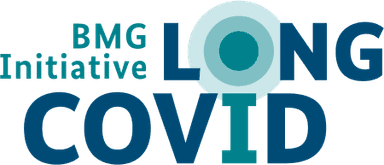Note: The following text is a guest article. They reflect the personal views of the author. The article is not an expression of opinion by the Federal Ministry of Health.
Guest article: Daniel Hattesohl
Daniel Hattesohl, founding member and chairman of the board of the German ME/CFS Society, addresses the special status of post-infectious diseases in medicine in his guest article. He focuses especially on the similarity of the symptoms of ME/CFS compared to those within a subgroup of those affected by Long-COVID.
Published on 05.10.2023

© Fotografin Elena Zaucke
What we need is a paradigm shift as far as ME/CFS, Long COVID and post-infectious diseases are concerned.
Coinciding with the introduction of the term "Long COVID" by a patient, Elisa Perego, another group of people suffering from the disease warned of the long-term consequences of the coronavirus pandemic: that is, people experiencing Myalgic Encephalomyelitis/Chronic Fatigue Syndrome (ME/CFS). Back in May 2020, people affected by ME/CFS and researchers drew attention to the fact that symptoms of a subgroup of people affected by Long-COVID were remarkably similar to those of ME/CFS. They alluded to the fact that (medical) history could repeat itself. Chronic ME/CFS cases following acute illness had already been documented from the 2002/2003 SARS pandemic (Lam et al., 2009).
What is ME/CFS?
ME/CFS is a severe, organic disease that occurs mostly after viral infections, including Epstein-Barr virus (EBV), influenza or enteroviruses. It is also known to develop - albeit less frequently - after bacterial infections, operations or whiplash injuries. In terms of disease severity, ME/CFS is somewhat comparable to multiple sclerosis (Hvidberg et al., 2015). ME/CFS is characterised by a significant worsening of symptoms after only a small amount of physical activity (post-exertional malaise). In addition, there are other symptoms such as fatigue, myalgias, orthostatic intolerance, neurocognitive problems ("brain fog") and hypersensitivity to light and sound (Institute of Medicine, 2015). People suffering from very severe ME/CFS are bedridden and often require artificial feeding (Montoya et al., 2021).
ME/CFS is not a new disease, indeed it has been described in the medical literature for at least 70 years. ME/CFS has been officially listed by the WHO since 1969. The disease has always occurred in clusters after epidemics and cluster outbreaks (the name Myalgic Encephalomyelitis was coined in 1955 after an infectious outbreak at several hospitals in London; The Medical Staff Of The Royal Free Hospital, 1957). However, sporadic cases are also quite prevalent.
ME/CFS is also seen to be following COVID-19
We know today that the people suffering from the disease had been warned that it would occur. A good dozen studies indicate that up to 50 percent of people affected by Long-COVID suffer from ME/CFS after six months of illness (although the number could be somewhat lower due to the selection bias of the outpatient clinics). ME/CFS is described by experts as "the most severe form of post-COVID". Many pathophysiological abnormalities found today in studies of long COVID have long been known from ME/CFS research. These include autoimmunity to adrenergic and cholinergic receptors, endothelial dysfunction and reduced cerebral perfusion (Ichise et al., 1992). Presumably, COVID-19 has caused the number of ME/CFS patients to double from 250,000 before the pandemic to 500,000 (data provided by KBV, 2023).
Nevertheless, no treatment or therapies are currently available. For decades, ME/CFS has lived a somewhat shadowy existence in medicine, the disease has been ignored, some of the patients have been subjected to psychiatric treatment and treated with contraindicated therapies (IQWiG, 2023). The medical profession's understanding of ME/CFS is still spotty. There are only two university outpatient clinics in Germany that specialise in ME/CFS and can only treat a fraction of patients.
The blind spot of medicine - post-infectious diseases
This is also attributable to a hundred-year-old blind spot in medicine regarding post-infectious syndromes or diseases. Yet postviral sequelae have already been described in the 19th and 20th centuries after the Russian and Spanish flu (Honigsbaum and Krishnan, 2020; Islam et al., 2020). Among others, the founder of modern nursing, Florence Nightingale, probably suffered from lifelong post-infectious symptoms after brucellosis and could hardly leave her bed for the last thirty-five years of her life.
Thomas Kuhn wrote in "The Structure of Scientific Revolutions" that "[scientific] discovery [begins] with the realisation of an anomaly, that is, with the realisation that nature has in some way failed to live up to the expectations generated by a paradigm that dominates standard science".
For too long, medicine has considered only acute courses, mortality and possibly prolonged convalescence from viral infections ("recovered or died"), but not the sequelae and after-effects. Post-infectious chronic diseases such as ME/CFS after EBV, influenza or now even after SARS-CoV-2 went beyond the scope of the old paradigm and were misinterpreted as psychogenic symptoms of "false convictions about disease" or "deconditioning".
We must embrace a new paradigm
A paradigm shift in medicine is clearly needed: The blind spot of post-infectious diseases must at long last be shed light on in a comprehensive fashion. They must be biomedically researched as diseases in their own right and all patients, irrespective of the trigger, must be provided with treatment. For example, the coalition agreement of the "traffic light" government provides for the establishment of competence centres for Long COVID and ME/CFS.
In order to understand Long COVID, the medical community must make use of the decades of research on ME/CFS and related diseases such as POTS (Postural Orthostatic Tachycardia Syndrome) and their experience with it, and also say goodbye to dubious axioms, for example, that psychogenic causes should be assumed in the case of organic "inconspicuousness". Often it is only a lack of pathophysiological and diagnostic research, in other words, you have not looked closely enough.
The medical community also needs to move away from the idea that exercise and physical activity can help anyone with ME/CFS. Patients suffering from ME/CFS tend to experience a worsening of their symptoms or condition as a result of the pathological post-exertional malaise. For this reason, international health authorities have issued a warning against being physically active while suffering from ME/CFS (e.g. NICE, 2021).
A pioneer in the field of post-infectious diseases is, for instance, Prof. Dr Scheibenbogen, who has been researching ME/CFS at the Institute of Medical Immunology at the Charité for over ten years. Today, she takes a conjoint approach to ME/CFS and Long COVID and heads a national clinical study group (NKSG) with several therapy studies. Another name that stands out is Prof. Dr. Iwasaki, who founded the Center for Infection & Immunity at Yale in June to research LC, ME/CFS and Lyme disease synergistically.
For this reason: Let's rethink! Let's get started!
Literature
Committee on the Diagnostic Criteria for Myalgic Encephalomyelitis/Chronic Fatigue Syndrome, Board on the Health of Select Populations, & Institute of Medicine. (2015). Beyond Myalgic Encephalomyelitis/Chronic Fatigue Syndrome: Redefining an Illness. National Academies Press (US). http://www.ncbi.nlm.nih.gov/books/NBK274235/
Honigsbaum, M., & Krishnan, L. (2020). Taking pandemic sequelae seriously: From the Russian influenza to COVID-19 long-haulers. The Lancet, 396(10260), 1389–1391. https://doi.org/10.1016/S0140-6736(20)32134-6
Hvidberg, M. F., Brinth, L. S., Olesen, A. V., Petersen, K. D., & Ehlers, L. (2015). The Health-Related Quality of Life for Patients with Myalgic Encephalomyelitis / Chronic Fatigue Syndrome (ME/CFS). PLOS ONE, 10(7), e0132421. https://doi.org/10.1371/journal.pone.0132421
Ichise, M., Salit, I. E., Abbey, S. E., Chung, D. G., Gray, B., Kirsh, J. C., & Freedman, M. (1992). Assessment of regional cerebral perfusion by 99Tcm-HMPAO SPECT in chronic fatigue syndrome. Nuclear Medicine Communications, 13(10), 767–772.
Institut für Qualität und Wirtschaftlichkeit im Gesundheitswesen (IQWiG). (2023). Myalgische Enzephalomyelitis / Chronic Fatigue Syndrome (ME/CFS) – Aktueller Kenntnisstand [N21-01]. https://www.iqwig.de/projekte/n21-01.html
Islam, M. F., Cotler, J., & Jason, L. A. (2020). Post-viral fatigue and COVID-19: Lessons from past epidemics. Fatigue: Biomedicine, Health & Behavior, 8(2), 61–69. https://doi.org/10.1080/21641846.2020.1778227
Lam, M. H.-B., Wing, Y.-K., Yu, M. W.-M., Leung, C.-M., Ma, R. C. W., Kong, A. P. S., So, W. Y., Fong, S. Y.-Y., & Lam, S.-P. (2009). Mental morbidities and chronic fatigue in severe acute respiratory syndrome survivors: Long-term follow-up. Archives of Internal Medicine, 169(22), 2142–2147. https://doi.org/10.1001/archinternmed.2009.384
Montoya, J., Dowell, T., Mooney, A., Dimmock, M., & Chu, L. (2021). Caring for the Patient with Severe or Very Severe Myalgic Encephalomyelitis/Chronic Fatigue Syndrome. Healthcare, 9(10), 1331. https://doi.org/10.3390/healthcare9101331
National Institute for Health and Care Excellence (NICE). (2021). Myalgic encephalomyelitis (or encephalopathy)/chronic fatigue syndrome: Diagnosis and management [NG206]. https://www.nice.org.uk/guidance/ng206
The Medical Staff Of The Royal Free Hospital. (1957). AN OUTBREAK of encephalomyelitis in the Royal Free Hospital Group, London, in 1955. British Medical Journal, 2(5050), 895–904.
Vita
Daniel Hattesohl is a founding member and Chairman of the Board of the German Society for ME/CFS. He studied medicine and had to put his studies on hold due to his ME/CFS condition. As chairman, he is committed to raising awareness and recognition of ME/CFS and is co-author of several studies.
